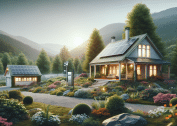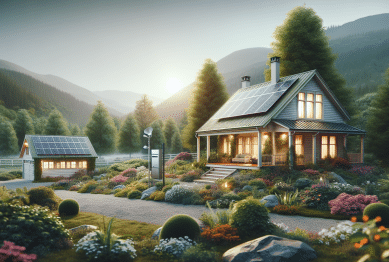Explore innovative techniques that help reduce water usage in your garden while maintaining lush, healthy plants. This guide uncovers smart irrigation, native landscaping, and creative reuse strategies, making it easier to enjoy beautiful gardens and support sustainability—all with practical steps you can start using right away.
Understanding Water Use In The Garden
Effective garden water management begins with understanding where and how water is used and sometimes wasted within a yard landscape. Many homeowners do not realize that a significant percentage of household water can be consumed outdoors, particularly during the peak of summer. Sprinklers, hoses, and even simple evaporation from lawns can quickly add up. Recognizing these patterns is essential for implementing efficient watering techniques that promote garden health and preserve natural resources at the same time.
Evaporation often causes water loss before it ever reaches plants’ roots. Hot, sunny days and exposed soil surfaces accelerate this process, making your garden thirstier than necessary. By using targeted watering approaches, such as drip systems or mulching, it is possible to keep root zones hydrated without wasting resources. These initial observations reveal a need for garden strategies that align with overall water conservation goals.
Knowledge of plant types and their varying water requirements can further optimize water savings. Native and drought-tolerant species typically demand less irrigation once established. By grouping plants according to their watering needs, you can limit unnecessary runoff and make the most of every drop. This mindful approach to gardening not only preserves water but can also lead to a healthier, more resilient landscape (Source: https://www.epa.gov/watersense/landscaping-tips).
Scope Of Smart Irrigation Systems
Switching to smart irrigation is one of the most effective ways to save water in the garden. Unlike traditional sprinklers or hand-watering, smart technology uses sensors and timers that deliver water only when plants need it. Weather-based controllers, for example, automatically adjust watering schedules based on rainfall, temperature, and humidity. This sophisticated approach not only reduces waste but ensures optimal watering for plant growth. Integrating these systems can lead to as much as a 50% reduction in outdoor water use (Source: https://www.epa.gov/watersense/irrigation-controllers).
Drip irrigation systems go even further by focusing water directly at the root zone rather than spraying over large areas. They minimize evaporation and prevent water runoff, making them ideal for flower beds, vegetable patches, and even containers. Homeowners can install basic drip lines with minimal investment and maintenance, immediately noticing an improvement in both efficiency and plant vitality. The result is a more targeted, responsible use of precious water resources without compromising the beauty or productivity of the garden.
Rain sensors and soil moisture monitors bring extra precision and convenience. These add-ons pause irrigation during wet weather or when the soil is already adequately moist, removing any guesswork from the process. Over time, these systems can contribute to significant savings on water bills, while supporting wider community conservation efforts. Adopting these smart systems forms a cornerstone for any sustainable garden strategy.
Choosing Native And Drought-Tolerant Plants
Gardening with native or drought-resistant plants is a natural way to reduce water needs. Plants that are adapted to local conditions require far less irrigation than exotic species. These varieties have evolved to thrive with available rainfall, making them more sustainable choices for eco-friendly landscapes. Selecting natives can boost biodiversity too, as they attract pollinators and beneficial insects essential to garden health. Instead of fighting the climate, homeowners can align their gardens with it, achieving beauty and resilience with minimal effort (Source: https://www.fs.usda.gov/Internet/FSE_DOCUMENTS/fseprd521100.pdf).
Many regional plant lists are available from local extension offices or horticultural societies, offering excellent starting points. These organizations can direct gardeners to suitable trees, shrubs, and ground covers that blend aesthetics with water savings. Blending drought-tolerant selections with water-wise gardening promotes environmentally sound habits and fosters neighborhoods that look beautiful and are built to last. Over time, the garden flourishes, and maintenance demands decrease, ensuring time and water are spent wisely.
Beyond saving water, incorporating these plants supports broader ecosystem functions. Deep-rooted natives aid soil health, reduce erosion, and can even filter rainwater before it enters local waterways. By designing with sustainability in mind, gardeners play a vital role in environmental stewardship. Native and drought-tolerant landscaping thus becomes both a practical and meaningful addition to modern homes.
Clever Mulching And Soil Improvement Tactics
Mulch acts as both a decorative finish and a moisture-retaining shield for garden beds. Covering soil with organic matter such as shredded leaves, straw, or compost slows evaporation and keeps soil temperatures more consistent. This means plants need watering less frequently, and roots stay healthier. Mulching is also an excellent way to recycle yard waste, turning it into a valuable resource that reduces the need for synthetic fertilizers and herbicides (Source: https://www.gardeningknowhow.com/garden-how-to/soil-fertilizers/benefits-of-mulching.htm).
Soil quality plays a huge role in how much water your garden holds. Well-structured soils, rich in organic matter, absorb and retain moisture more efficiently than compacted or sandy soils. Composting kitchen scraps and yard clippings adds this organic content back into your garden, supporting healthy microbial activity and better root growth. Over time, these practices enable the soil to function as a natural sponge, maximizing the impact of every drop of water delivered.
Combining mulching with smart soil management sets a foundation for long-term water efficiency. It also improves plant immunity and reduces weeding requirements, creating a garden that is low-maintenance and high-yield. Simple seasonal routines, like topping up mulch and regular composting, bring about cumulative benefits that can prevent unnecessary watering and deliver ongoing rewards for both plants and gardeners.
Harvesting And Reusing Rainwater Creatively
Rainwater harvesting enables gardeners to collect and use natural rainfall for landscape irrigation. By setting up barrels, cisterns, or even underground tanks, it’s possible to gather significant volumes of water from rooftops and other impermeable surfaces. This approach reduces demand on municipal sources, avoids additional costs, and supplies plants with chemical-free water. It’s a sustainable, low-impact choice that works even in regions with regular drought restrictions (Source: https://www.energy.gov/energysaver/using-rain-barrels).
Stored rainwater can be directed to gardens via gravity-fed drip lines or watering cans. This flexibility lets homeowners align irrigation more closely with actual plant needs, minimizing overwatering and runoff. Even basic systems are affordable and can be custom-sized to suit the space or intended application. In climates with unpredictable rainfall, this supplemental supply provides welcome peace of mind and ongoing support for garden health.
When combined with water-wise landscaping and proper soil management, rainwater harvesting closes the loop on garden sustainability. It demonstrates a thoughtful, eco-friendly commitment that inspires neighbors and communities to embrace similar strategies, driving collective progress toward a greener future. Harnessing these natural resources ensures gardens remain lush, vibrant, and resilient—even as climate challenges increase.
Behavioral Habits That Reduce Water Waste
Beyond technical solutions, daily habits greatly influence water efficiency in any landscape. Simple actions, like watering early in the morning or late evening, significantly reduce evaporation and deliver moisture directly to plant roots. Avoiding overwatering by monitoring weather reports and soil conditions ensures every application is necessary and purposeful. Taking the time to walk the garden, check for leaks, and fix broken fittings also prevents ongoing waste. These habits are easy to develop and quickly become second nature.
Encouraging mindful practices across all family members or residents fosters a sense of shared responsibility. Placing reminders, labels, or informational signs near taps and hoses can prompt careful use, especially in rental properties or community gardens. Engaging children in tracking rainfall or observing the effects of drought-tolerant landscaping helps build a water-conscious culture from an early age (Source: https://www.botanicgardens.org/blog/ten-tips-saving-water-garden).
Behavioral change also opens the door to experimenting with innovative watering methods and garden layouts. By regularly evaluating what works and upgrading outdated systems, home gardeners can maximize efficiency—sometimes dramatically. Over time, small improvements add up, leading not just to lower bills but a garden that thrives throughout all seasons. Sustainable practices soon evolve from conscious effort to effortless routine, carrying positive impact far beyond the property line.
References
1. U.S. Environmental Protection Agency. (n.d.). Landscaping Tips. Retrieved from https://www.epa.gov/watersense/landscaping-tips
2. U.S. Environmental Protection Agency. (n.d.). Smart Irrigation Controllers. Retrieved from https://www.epa.gov/watersense/irrigation-controllers
3. U.S. Forest Service. (n.d.). Drought Tolerant Plants for Landscaping. Retrieved from https://www.fs.usda.gov/Internet/FSE_DOCUMENTS/fseprd521100.pdf
4. Gardening Know How. (n.d.). Benefits of Mulching. Retrieved from https://www.gardeningknowhow.com/garden-how-to/soil-fertilizers/benefits-of-mulching.htm
5. U.S. Department of Energy. (n.d.). Using Rain Barrels. Retrieved from https://www.energy.gov/energysaver/using-rain-barrels
6. Denver Botanic Gardens. (n.d.). Ten Tips for Saving Water in the Garden. Retrieved from https://www.botanicgardens.org/blog/ten-tips-saving-water-garden









